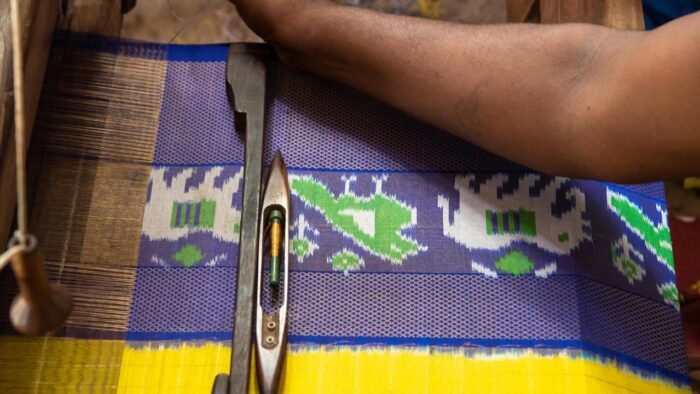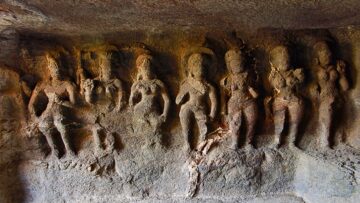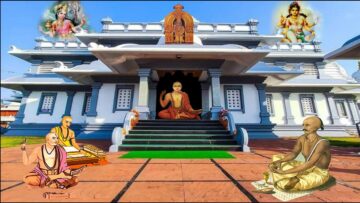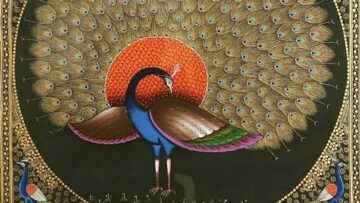Abstract:
The present research paper is written to study the sacred synergy between the motifs seen in the temple architecture of Kanchipuram and motifs woven on the famed Kanchipuram silk sarees. Various sacred motifs like the Yazhi (a mythical composite animal), iruthalaipakshi or gandabherunda (two headed eagle), mayil (peacock) are seen woven on the Kanchipuram sarees. These motifs are often an exact copy of the motifs seen carved on the temples of Kanchipuram that were built more than 1400 years ago. Data was collected through personal observation of motifs in temples of Kanchipuram,by analysing specimens in the author’s personal collection and textile museums as well as by interviewing weavers of Kanchipuram. The research approach was both qualitative and quantitative. The paper highlights the fact that varied sacred motifs inspired by the temple architecture of Kanchipuram are being used in the weaving of Kanchipuram silk sarees for over a thousand years. The weavers of Kanchipuram have been inspired by the beauty and spirituality of the temple carvings and have recreated those motifs in their textiles as textiles too were created as a sacred offering to the Divine.
Introduction
India has a tradition of handloom weaving that goes back to over 5000 years. India’s weavers have been clothing the world for millennia. Creating design motifs on a hand operated loom was perhaps the earliest method of decorating the fabric followed by dying, printing, embroidery and appliqué work.
Kanchipuram in Tamil Nadu has been one of the oldest and most famous weaving centers of India for more than 1500 years. The famous silk sarees of Kanchipuram are renowned for their rich and varied motifs. Kanchipuram is mentioned in the books of the Sanskrit grammarian Patanjali who lived in the 3rd–2nd century BC. Chinese monk Hiuen Tsang visited Kancheepuram during the reign of Pallava King, Narasimha Verman I in 7th century CE. He mentions a large number of Hindu, Buddhist and Jain temples as well as a flourishing weaving industry. The cotton cloth woven in Kanchipuram was exported to the Roman Empire and was much valued. Thus, Kanchipuram has been, both, a temple city as well as an important weaving cluster of India for more than 1400 years. As all arts are interdisciplinary by nature, it stands to reason that the weavers of Kanchipuram were inspired by the beautiful motifs they saw on temple walls all around them, and recreated these exquisite motifs in their textiles.
The research approach was qualitative as well as quantitative. Form analysis, a variation of content analysis, was used to systematically document the common motifs seen in Kanchipuram weaves as well as four main temples of Kanchipuram, the Kailasnathar Kovil, the Vaikuntha Perumal temple, the Kamakshi Amman temple and the Ekamreshwar temple, dedicated to Lord Shiva. Information related to the motifs were collected from primary and secondary sources. Primary source comprised of field visits to temples and examining specimens of Kanchipuram sarees in the author’s personal collection as well as studying samples from various textile museums and saree emporiums. Primary source data collection also included interviewing weavers and designers of Kanchipuram as well as talking to experts in the field of Iconography like Dr. G. B. Deglurkar, ex chancellor of Deccan College of Archeology, Pune and Venkatesh Narasimhan, former MD of Co-Optex, the apex weaversweavers’ body of the state of Tamil Nadu.
Secondary sources of data collection were books, articles, magazines, online visual collections, and online articles.
Findings and Interpretations
Every social and religious group in India has definite established norms towards colour and design of the textiles they prefer to wear. The Kanchipuram silk saree is no exception to it.
Sacred animal motifs like the peacock, the parrot, the elephant, the two headed eagle, the Pallava lion carved in the temples of Kanchipuram have been inspiring the weavers of Kanchipuram for over a millennium. Kanchipuram was an important seat of learning and a sacred city for more than 2000 years. It was the capital of Pallavas and they built many exquisite temples here.
A close examination of the motifs found in the temples of Kanchipuram and in the weaves of Kanchipuram indicates that there was a definite sacred synergy between the two. The motifs carved on temple walls are replete with sacred symbolism. The weavers of Kanchipuram tried to infuse their textiles with the same sacred motifs as weaving was an act of worship as much as visiting the temple.
The study of design motifs on Kanchipuram sarees reveals that like all other art and craft forms of India, the textile industry of Kanchipuram too was deeply influenced by Sanatana Dharma. Sacred motifs like the rudraksha, the tulsi plant, the araimaadam or the temple niches created for keeping lamps, the holy discus of Shri Vishnu, the Chakra, the hamsam or the swan of Devi Saraswati, the kalasha, or the sacred pot filled with water were all adapted from temple architecture and woven into the gorgeous Kanchipuram silk saree.
Textiles woven in Kanchipuram are symbolic forms deeply rooted in the vocabulary of Hindu aesthetics. Motifs used in weaving the textiles of Kanchipuram are derived both from nature like flowers (mallimoggu, kamalam), trees (kalpavriksham) animals in a forest (vanasingharam) and from sacred objects and mythical creatures with roots in Hindu scriptures like the two headed eagle, Gandabherunda and the distinctive Pallava Yazhi, a composite animal consisting of several animals. The designs are essentially traditional and are deeply rooted in scriptural stories of Hindu Dharma.
Hindu view of art states that our minds perceive everything through our senses. This perception is called Rasanubhuti. In both Vedic and Puranic literature, there are mentions of this power of sense-perception that invokes a particular feeling within us, the Rasa-Bhava. The main aim of all forms of art as per Hindu theory of aesthetics is that the art object has to invoke the desired rasa in both the creator of the art as well as in the Rasika, the consumer.
Indian art critic, Asit Haldar says ‘All ceremonial symbols convey meaning. Symbols are languages much easier to learn and understand in order to express the spiritual reality through them.’ This is evident in both the temple sculptures of Kanchipuram as well as in the saree motifs inspired by them.
Hindu theory of art regards any art object as a repository of communicable meanings, which are deeply symbolic and convey something significant to both the creator as well as the observer. The art object is only a medium for conveying those meanings.
The meaning has to manifest itself in the artist’s imagination before being materialised in some visual form. The artist, in this case, the weaver, must meditate upon the meaning until such time as he is able to communicate the symbolic meaning effectively through his/her work. Ananda Coomaraswamy has described this phenomenon as ‘There cannot be imagined an art without meaning.’ The study of motifs in Kanchipuram sarees is therefore a study of the meaning, as manifested in the temple sculptures that inspired them.
Temple motifs continue to command central positioning in Kanchipuram saris. Woven as scattered body motifs and repeated on the borders or pallus to form a design pattern, motifs inspired by temple sculptures are juxtaposed with the solid colours the Kanchipuram Sarees are so famous for. Kanchipuram sarees in classic Indian colours of kumkumam or vermillion red, turmeric yellow, banana flower purple and the famed M S electric blue are enhanced by the placement of sculptural motifs recreated from the architectural panels seen in the temples of Kanchipuram. These motifs invoke the sense of the sacred in the weaver as well in the wearer of the sarees. These motifs tell stories from our scriptures and lend a symbolic significance to the fabrics.
Inspired by the magnificent religious architecture of the Pallavas, Pandyas and the Chozhas, ther temple borders of Kanchipuram sarees replicate temple Gopurams soaring upwards in a linear progression. Pillars, columns, lamp niches, rudraksha beads all find a place on the saree borders. Stand alone motifs of animal figures found on temple walls like elephants, horses, lions, birds, peacocks, kalash (pot) and imaginary figures such as the yazhi (part lion/ horse and part elephant) and the Makara (part lion, part crocodile) decorate the saree imbibing the textile with a symbolic significance. The textile thus produced is not just a cloth, it is a sacred symbol full of religious meaning.
The weavers of Kanchipuram belong to a community called the Padma Saliyars, a devout Hindu community that till today perceives their craft as a sacred duty. The weavers of Kanchipuram believe that they are the descendants of Sage Markandeya, who was the master weaver for the Gods themselves. When the weavers of Kanchipuram weave sarees, they weave a sacred textile that is hoped to bring happiness, health and prosperity to the user. Weaving saris is not just a commercial activity, it is a sacred duty. It is the Dharma of the weaver to create a beautiful textile imbibed with sacred meaning, just as it the Dharma of the Sthapathi (temple architect) and the Shilpi (sculptor) to create a temple sculpture imbibed with sacred meaning.
Every stage of weaving the saree is accompanied with a religious ritual, from laying out the warp on the loom to the weaving of the final line, taking the saree off the loom and selling it. The loom is worshipped as Goddess Lakshmi.
In her account of the theory and practice of the craft of the Vishvakarmas, Sashikala Ananth states that, ‘The sculptor learns to represent on stone, wood, metal, or earth, the
essence of his inner understanding.’ What the shilpi does with stone, the Kanchipuram weaver does it with silk yarn.
In essence, both art forms reflect the same view of Hindu art, that the sacred object is merely the manifestation of a deeper, unsaid, symbolic meaning, the Rasa that is inherent within it.
The weavers of Kanchipuram as well as the sellers of their products truly believe that they are not just producers or vendors of textiles, but providers of sacred weaves. Even in big saree stores in Chennai, there is often a temple with a presiding priest, who offers a small pooja to the deity, with the sarees and other articles of clothing bought are ritually offered to the deity, mantras are chanted for the articles of clothing to be imbibed with auspiciousness and only then the bags are offered to the customers. This is not different from the experience devotees have when they go to a Hindu temple for a Darshan. I have witnessed this ceremony personally in Varalakshmi Silks showroom in Chennai. This aspect was well brought out by Arti Kawlra in her research paper titled ‘Kanchipuram Sari, Design for Auspiciousness’.
Most traditional motifs woven in Kanchipuram sarees either serve a protective function of guarding the wearer against the evil eye or they are a symbol of auspiciousness. A closer look at these motifs reveals the rich history of the design vocabulary that is common across diverse art forms, from painting to temple sculptures, to kolam to weaving.
Some of the design motifs in Kanchipuram sarees most commonly inspired by temple architecture are as follows:
Temple Motif
The temple tower motif is one of the holiest designs or motifs used by the weavers of Kanchipuram. It is also known as the Gopuram design. A Gopuram is the ceremonial gateway to the temple. When woven on the borders of a saree, it It is supposed to bestow divine blessings upon the wearer.
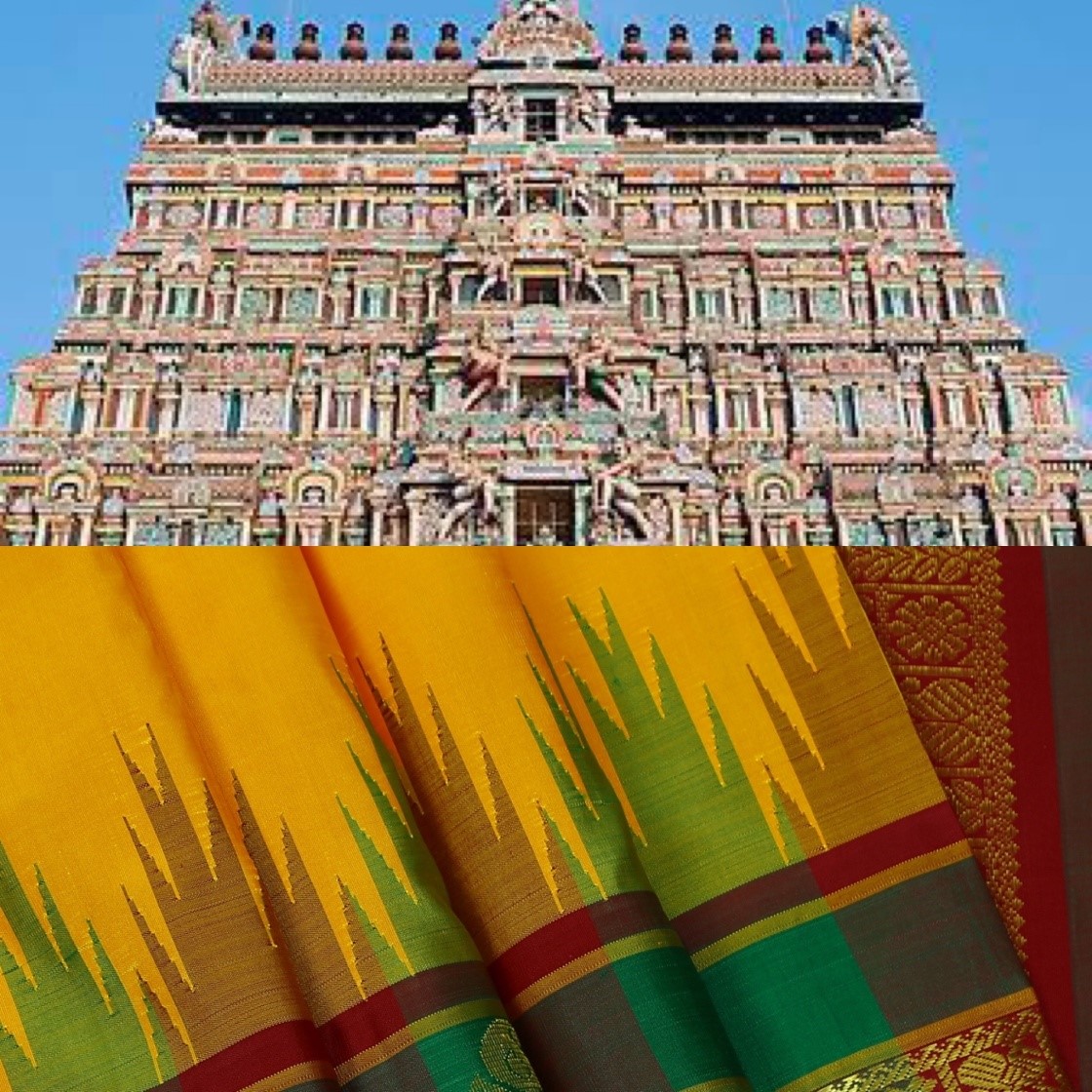
The temple motif consists of a series of large tapering triangles woven along the border of the entire saree in an imitation of the lofty temple Gopurams. They are woven into the fabric of the sari in the interlocked-weft technique, making the triangles point vertically upwards.
Yazhi
The Yazhi is an imaginary creature. Known as the Vyala or Vidala in Sanskrit, it is portrayed as
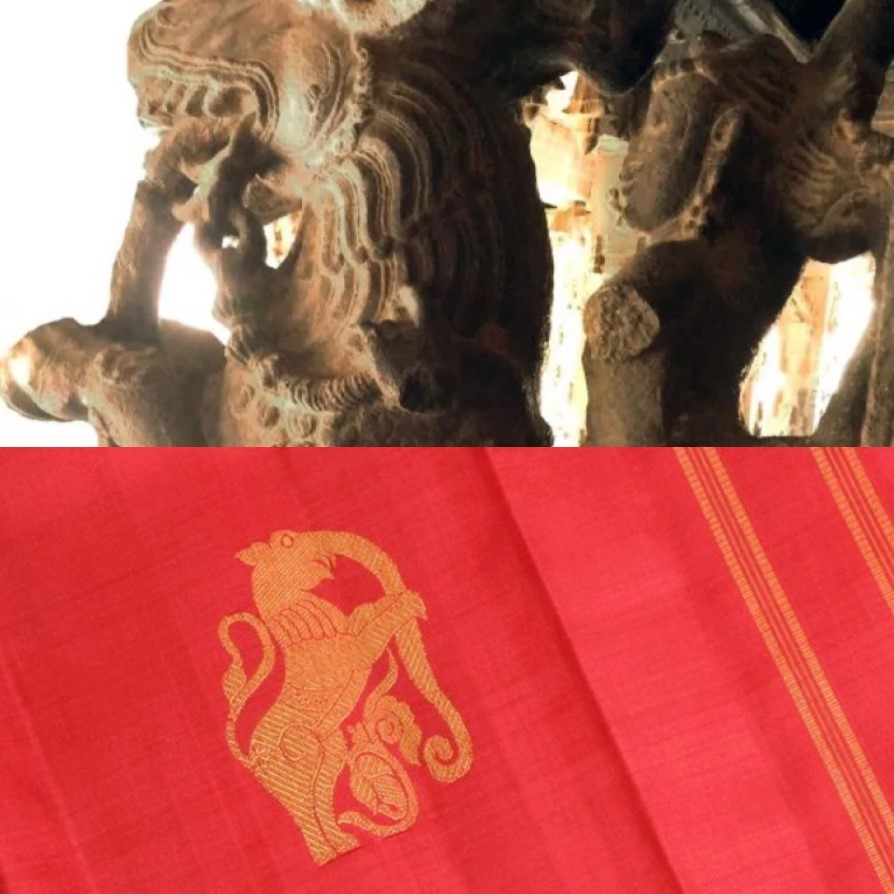
an animal with a cat like body, with the head of a lion and with tusks like with that of an elephant. Yazhi is the animal-mount or Vahana of Lord Budha, one of the Navagrahas. They are carved at the entrance of the temples. In Kanchipuram sarees, the yazhi motif is woven in the borders, the pallu, and also used across the body of the saree. These physical attributes of the yazhi are symbolic of the abilities of the animals, e.g., the strength of the elephant, the ferocity of the lion and the speed and agility of the horse, all three qualities much desired in a human being. Yazhi sculptures are a common feature on the walls of the Kailasnatha temple as well as Varadharaja Perumal temples in Kanchipuram.
AraiMaadam
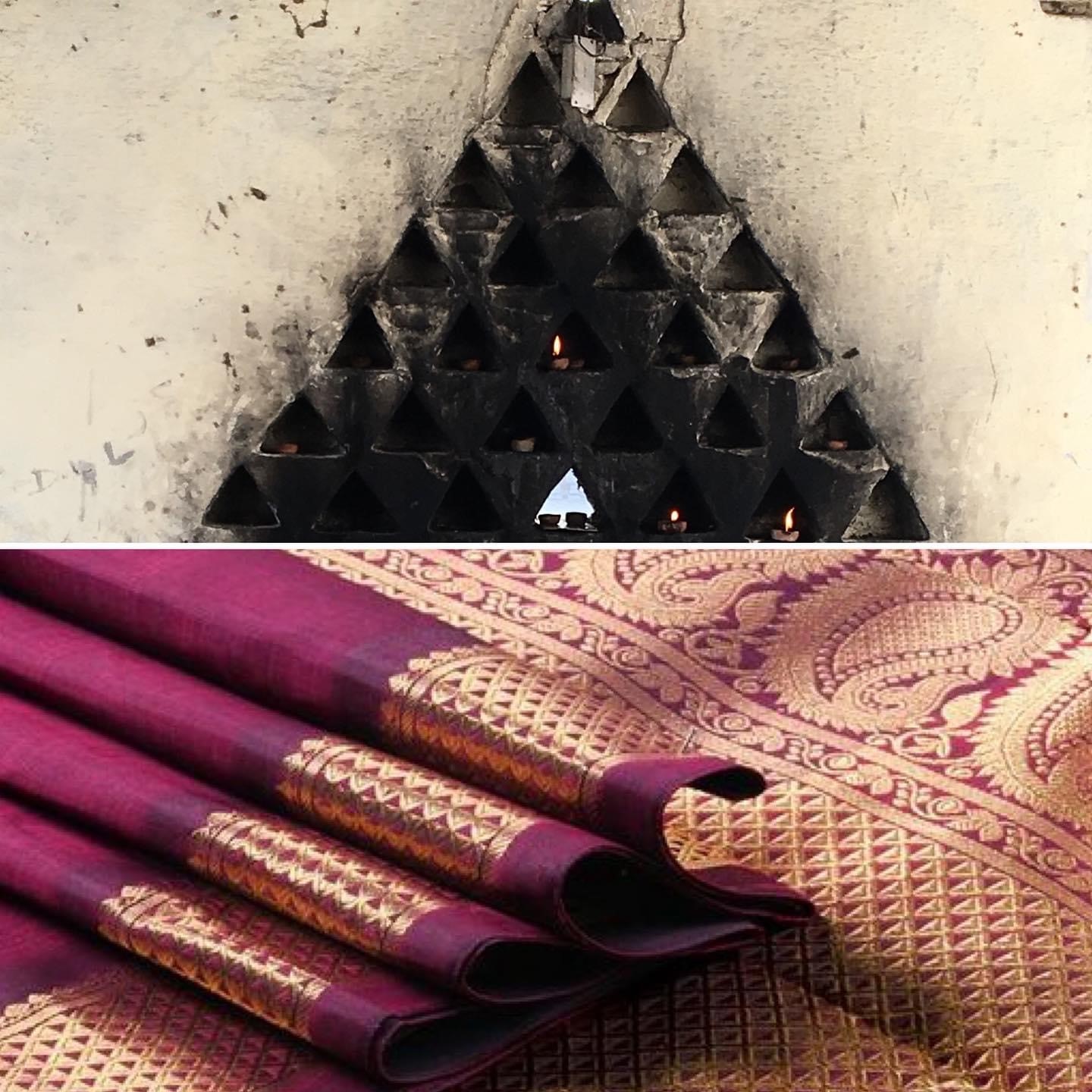
AraiMaadam or ‘half niche’, is the triangular niche seen in the walls of the temples of Kanchipuram. They are meant for lighting diyas. These niches have inspired the famous AraiMaadam border in Kanchipuram sarees. This border is much sought after in the traditional nine yard sarees and dhotis worn by the bride and the groom for the wedding ceremony. According to Shri T. N. Venkatesh, former MD of cooptex, this border is preferred because it looks the same on both sides. The implication is that the young couple should remain steadfastly together in good times as well as bad times.
Annapakshi
The Annapakshi or the goose or the Hamsam is a favourite motif of Kanchipuram weavers. It is often found in temple sculptures. In Vedic literature, the Hamsam is associated with the sun and divine knowledge. It has the ability to discern, and can pick out one drop of milk mixed in an ocean of water. In temple sculpture of Kanchipuram, Sarasvati, the goddess representing learning, culture and the arts is shown with the Annapakshi as her vahana or mount.
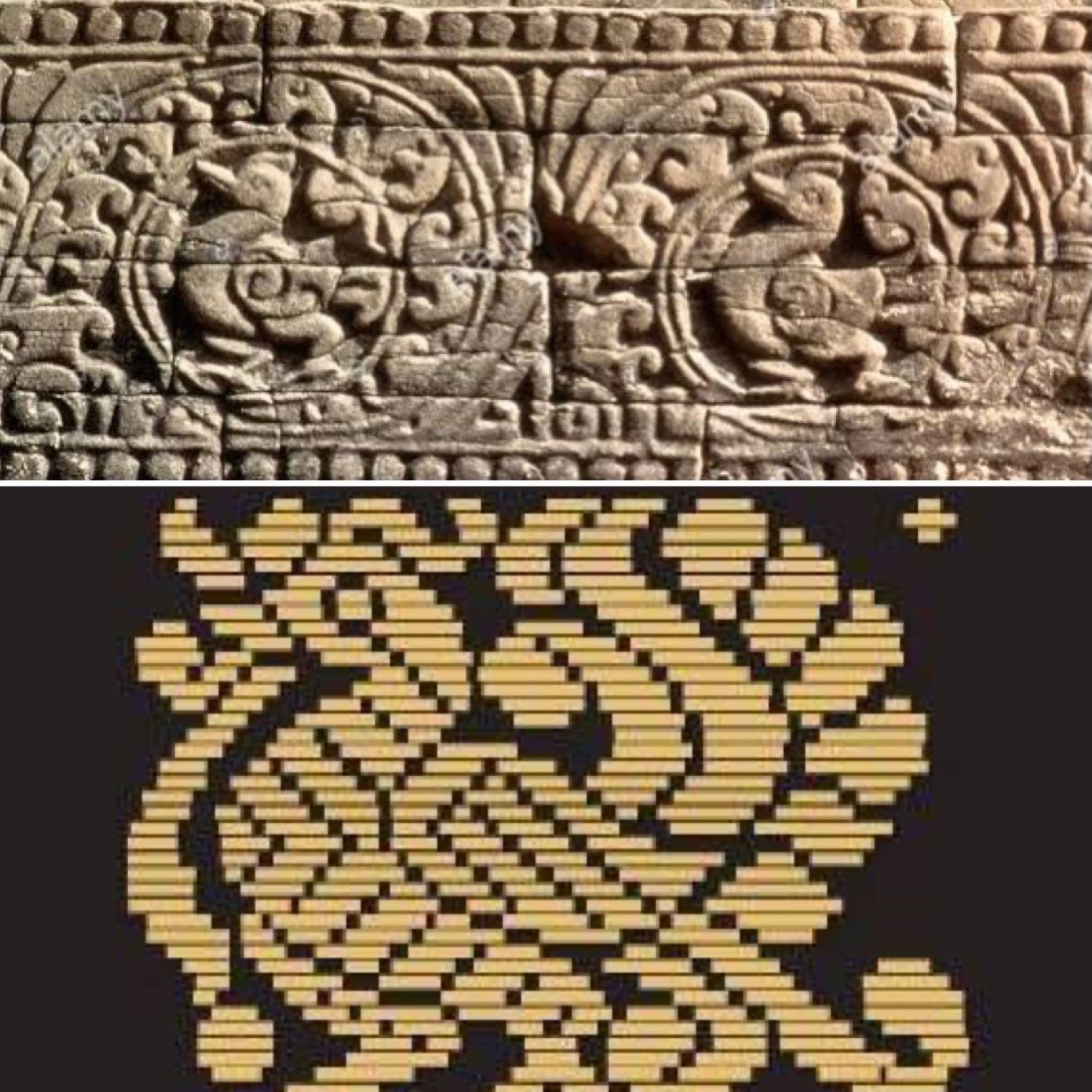
Peacock
The peacock or mayil has been a favourite motif in India since the Sindhu Saraswati civilisation days. It was seen painted on burial pottery dated to 2000 BCE. The peacock was painted carrying a human form within it, probably with the belief that they carry souls into the afterlife. Peacock is associated with immortality, courtship, fertility as well as wisdom and protection, as it is the vahana of both, Saraswati and Skanda, the General of Indra’s army. The peacock seen
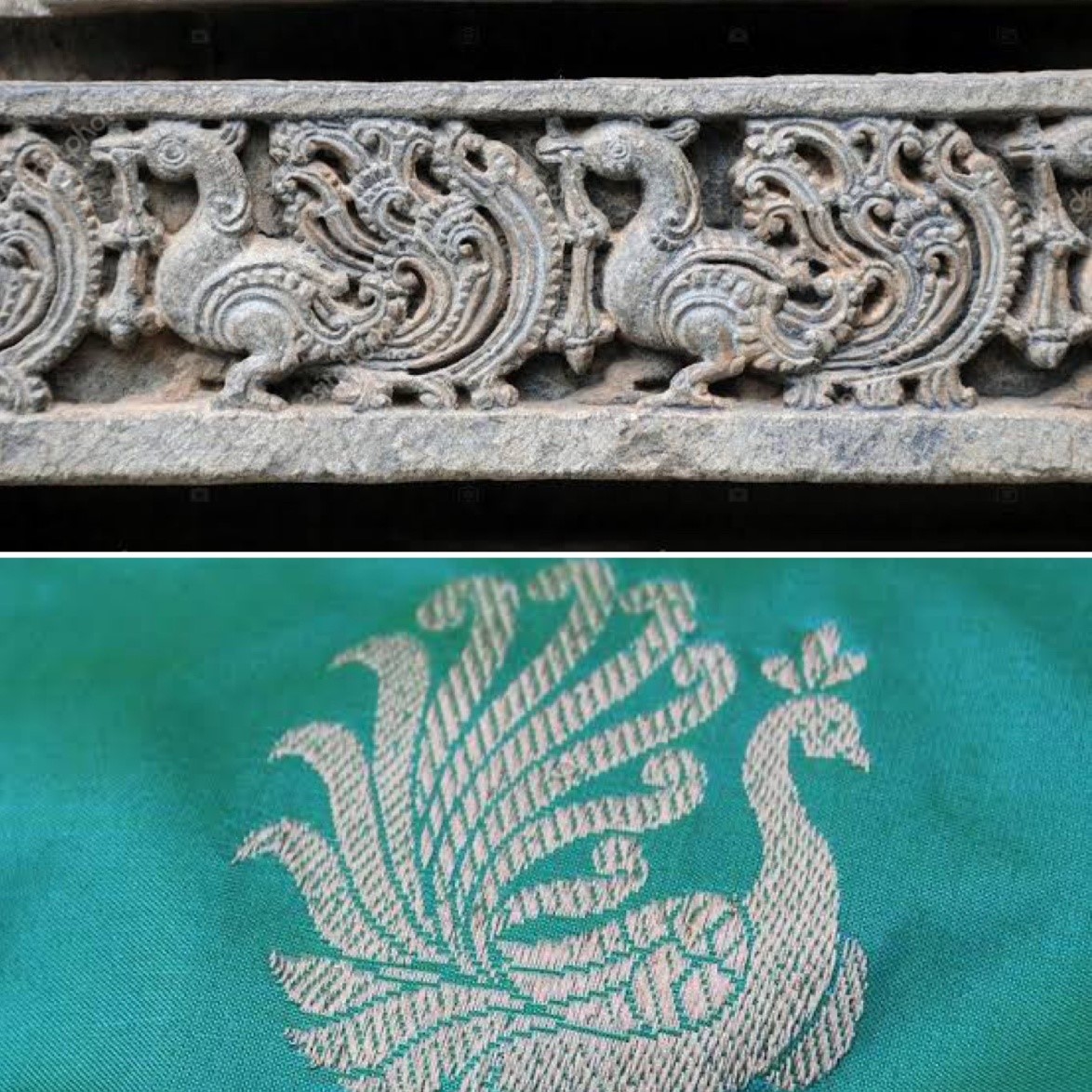
on Kanchipuram sarees is a replica of the peacock motifs seen in the temples of Kanchipuram. A 12th century Tamil text even describes the city of Kanchipuram as a peacock, with the Varadaraja Perumal temple as the head and the Ekamreshwar Shiva temple as the feathers. The mayilchakram or alternating peacocks and discus motif has been considered a very auspicious motif by Kanchipuram weavers.
Parrot
The parrot or Kili is another favourite motif of Kanchipuram weavers. The parrot serves a symbolic function as a messenger for lovers. It is associated with Manmatha and Rati, the God and Goddess of love. Goddess Kamakshi of Kanchipuram is depicted with the parrot in her right hand. The parrot motif is associated with courtship, love and passion and is often a motif
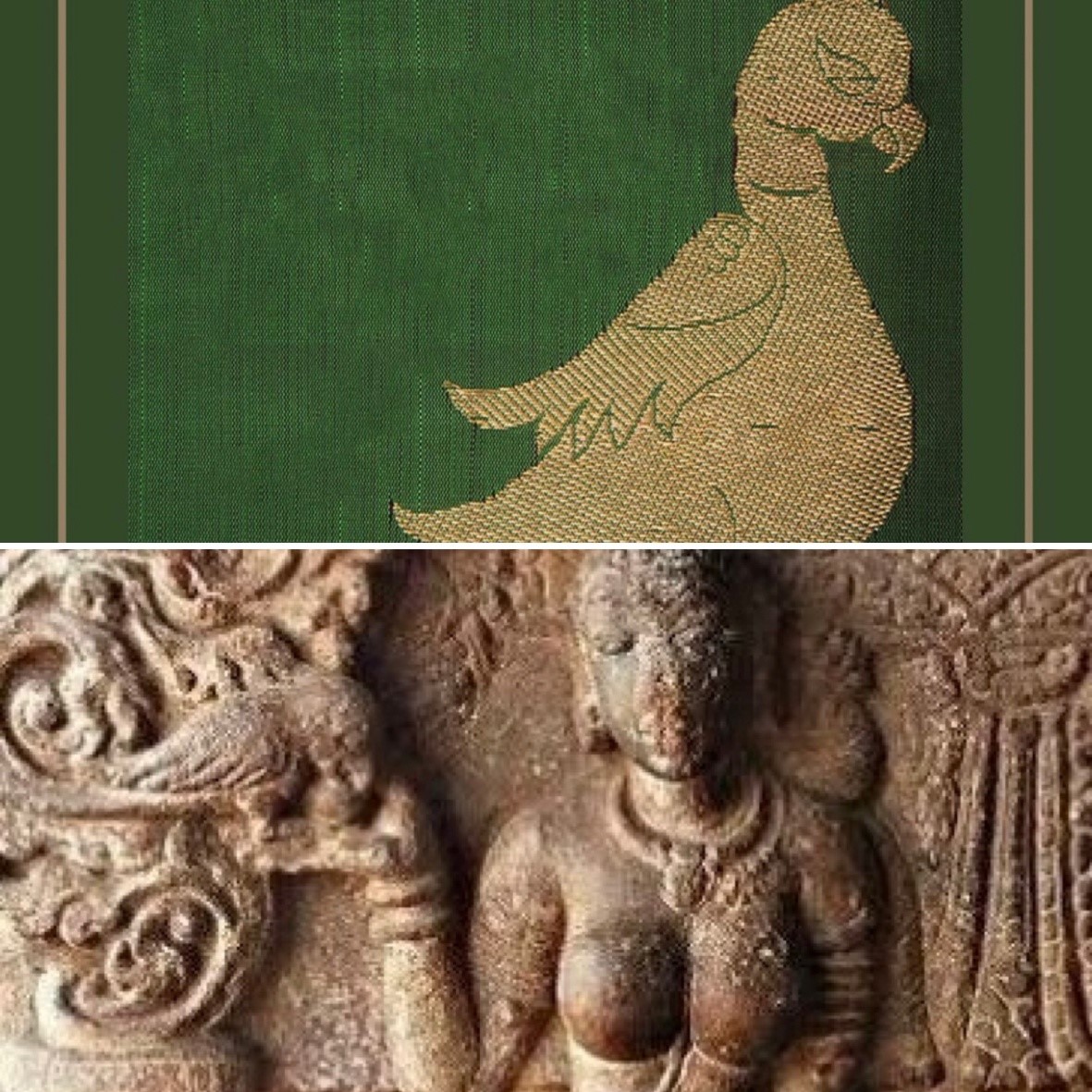
preferred on bridal sarees. The parrot motif inspires the Kanchipuram weavers not only in their design language, but the distinctive green colour of the parrot, kilipacchai, is also considered auspicious for festive occasions.
Elephant
Elephant or yanai is another favourite motif common to temple sculptures as well as Kanchipuram sarees. The symbol of the elephant has appeared throughout Indian history right from the Sindhu Saraswati civilisation days, when it was depicted on seals. The elephant is considered an auspicious animal, traditionally associated with prosperity. Goddess Lakshmi is often depicted as being flanked by two elephants carrying water. It also symbolises royalty, strength and wisdom. In the temples of Kanchipuram, the elephant is often shown at the base of the Adhishthana or temple platform holding aloft the structure. In Kanchipuram sarees, the elephant is an oft repeated motif, both in borders as well as in stand alonestandalone booties on the body of the saree.
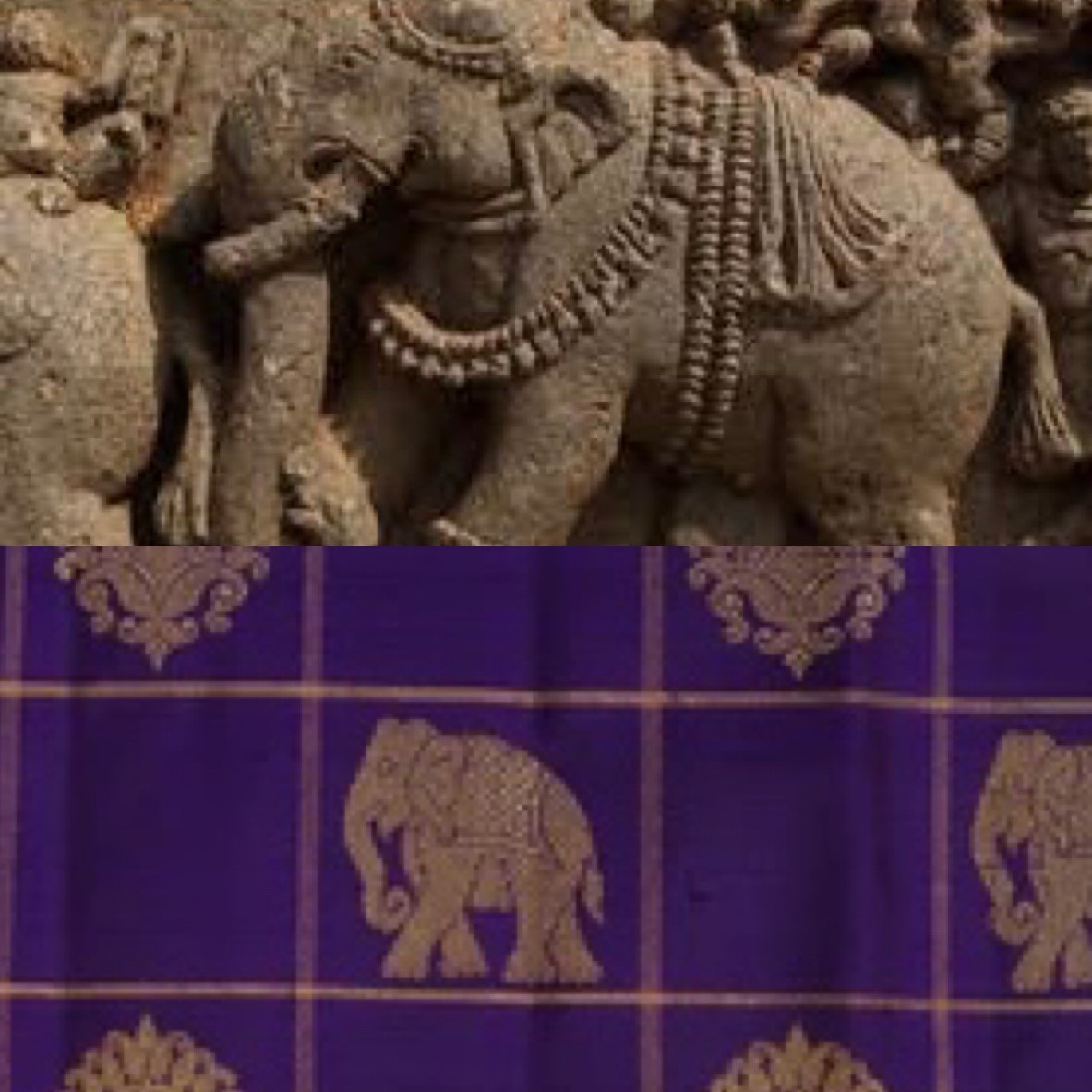
Lion
The Pallavas were prolific temple builders. Their royal emblem was the Sinham or the lion. It is often seen at the base of pillars in Pallava era temples of Kanchipuram like the Vaikuntha Perumal temple. The Pallava lion is replicated faithfully in the Kanchipuram weaves as a symbol of ferocity.
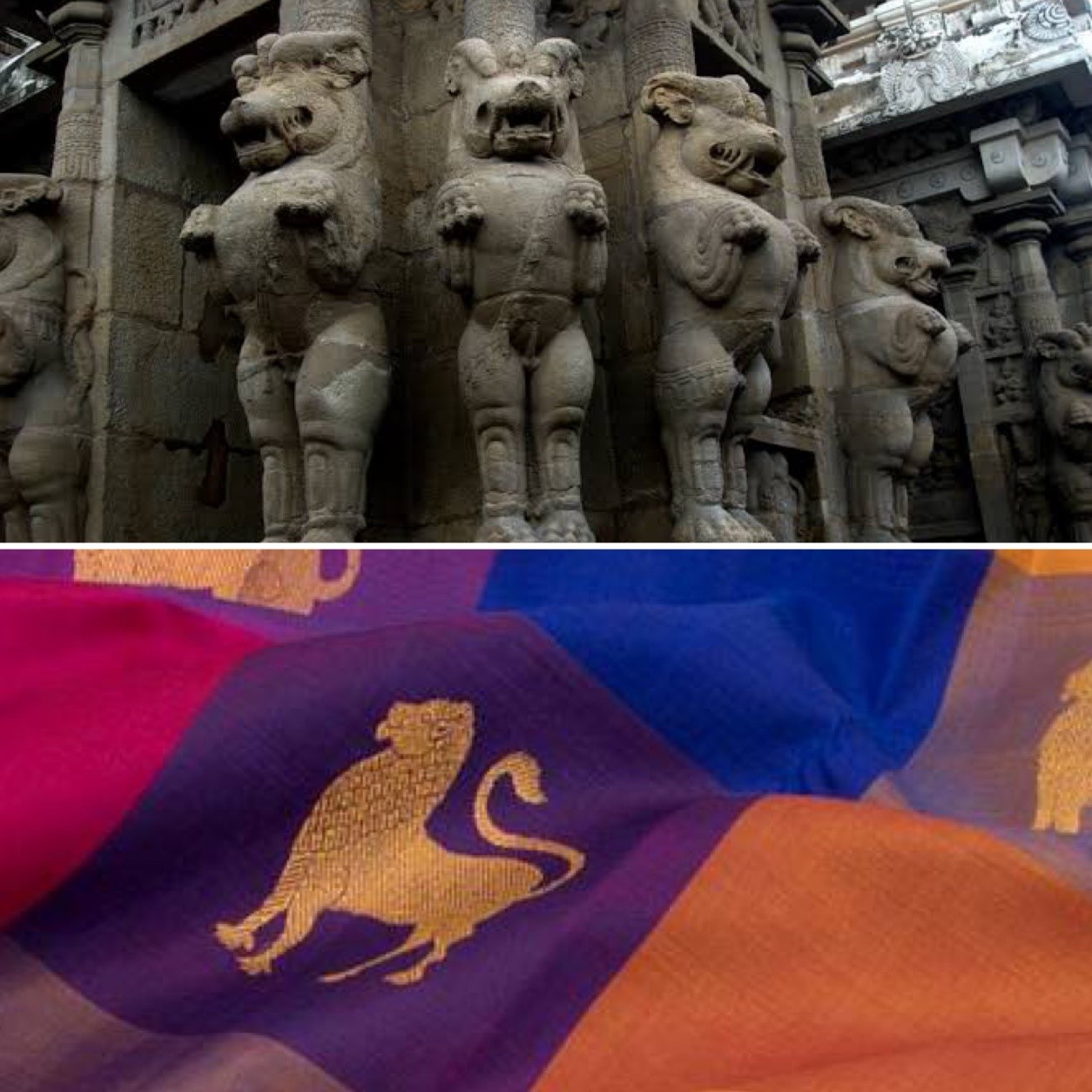
Lotus
The lotus flower or kamalam is a favourite motif in Indian art and iconography. It is the seat upon which Gods and Goddesses are often depicted. The lotus is the symbol of spiritual awakening. It rises from the muck of a pond, to bloom untouched by its squalid surroundings. It is a metaphor for the harmonious unfolding of spirituality within us. The 3 stages of the lotus, bud, utpala (mid-blossom) and the full blossomed lotus throne represent the past, present and future respectively. The lotus as a motif is seen everywhere in temple architecture. On Kanchipuram sarees, it is used as a repeating motif on borders as well in stand alone booties on the body of the saree.
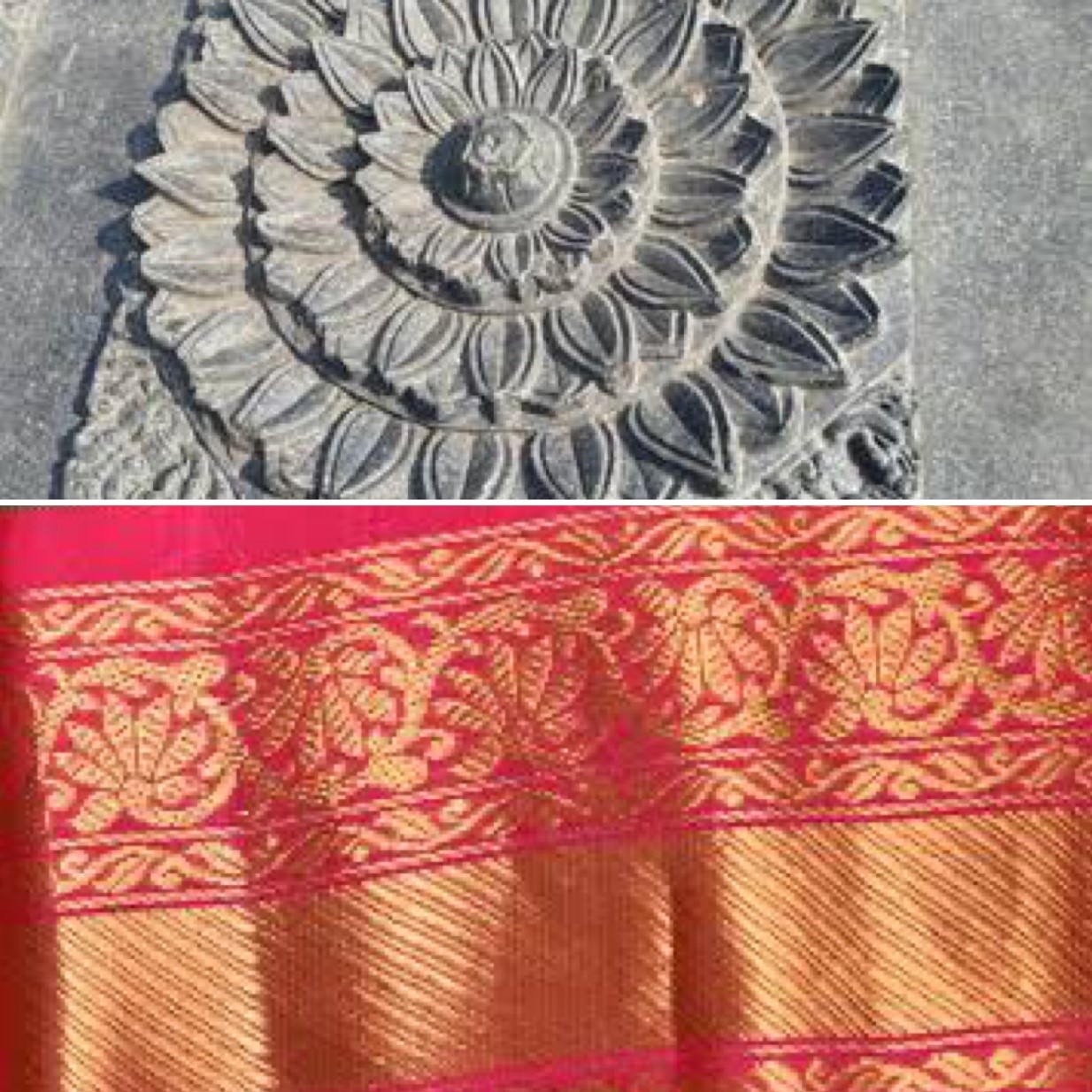
The Two Headed Eagle
The two headed eagle known as Gandabherunda is a motif replete with religious symbolism. Known in Tamil as the IruthalaiPakshi, the Gandabherunda is believed to possess immense magical strength. It is considered to be an avatar of Lord Vishnu and is often seen on Shri Vishnu temples. In Kanchipuram sarees it is often used as a corner motif.
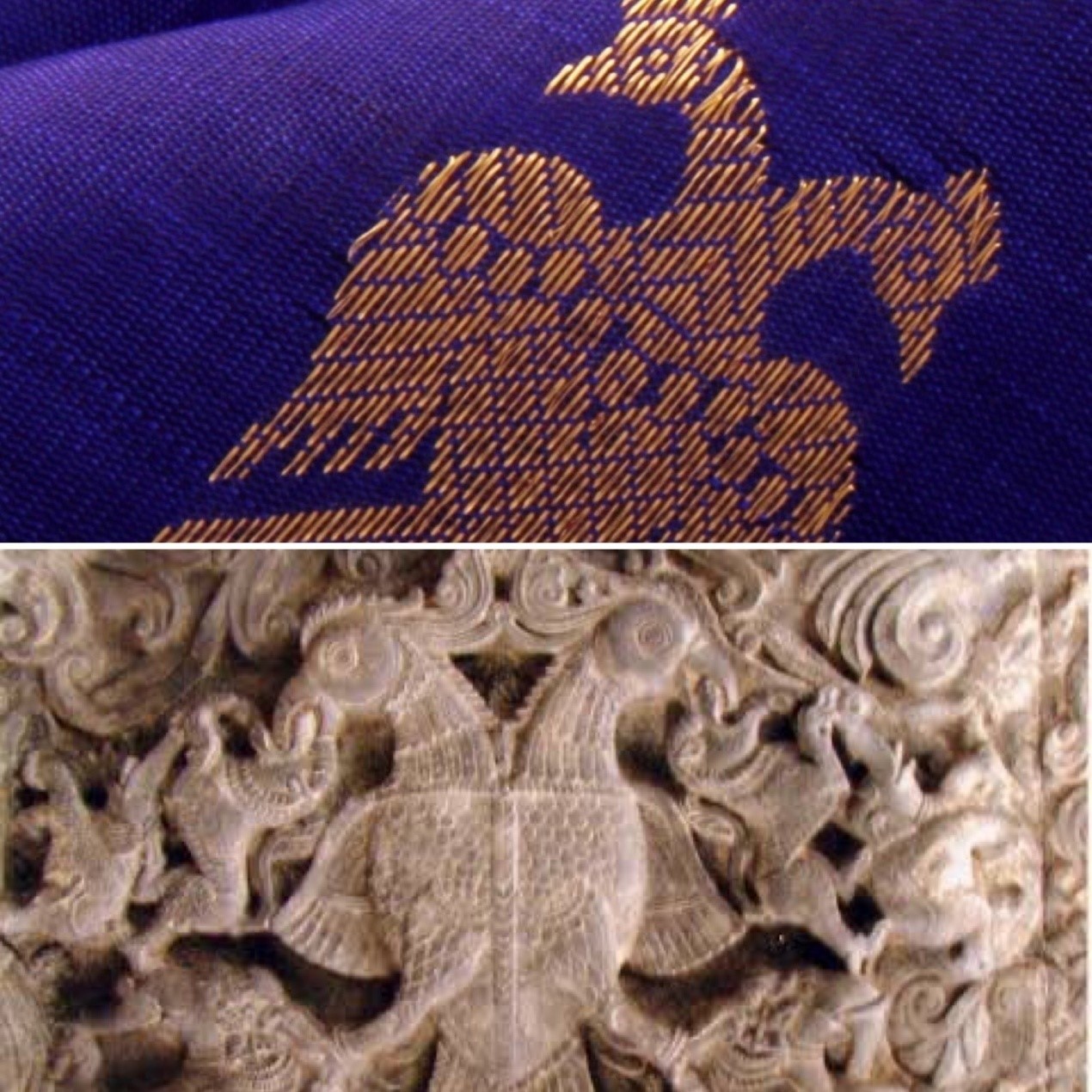
Conclusion
History of a textile motif is usually discovered from sources that have nothing to do directly with textiles. Textile motifs are inspired by nature, religion, culture and beliefs of the people. In India, textiles were always considered sacred and motifs woven into them had a deep symbolic meaning.
The weavers from the temple town of Kanchipuram are deeply spiritual and see themselves as artists who bring auspiciousness into the lives of people through their textiles. Many of the motifs used in Kanchipuram sarees are directly inspired from the temple sculptures of Kanchipuram and have a deep symbolic meaning. Just as temple sculptures are supposed to invoke a certain RasaBhava in the devotee who looks at them, the motifs on Kanchipuram sarees are supposed to invoke certain favourable attributes in the people who wear them.
In conclusion, there is a sacred synergy between the temple sculptures of Kanchipuram and some of the motifs used in Kanchipuram sarees. Just as the significance of temple sculptures lies in the rasa or feelings they invoke in the observer, the significance of the motifs used in Kanchipuram sarees lies in the feelings of auspiciousness and purity they invoke in the wearer.
Bibliography
Chatterjee, Gautam & Chatterjee, Sanjay & Chatterjee Sanjoy, “Sacred Hindu Symbols”
Kawlra, Arti, “Kanchipuram Sari: Design for Auspiciousness”, Design Issues , Autumn, 2005, Vol. 21, No. 4
Sashikala Ananth, “The Institutions of
the Vishwakarma,” Architecture + Design (Sept.-Oct. 1991)
Nath R , “Element of Indian Art and Architecture”, The Historical Research Documentation Programme
Mukerjee, Radhakamal, “Rasa as springs of Art in Indian Aesthetics”, Journal of Aesthetics and Art Criticism, Vol. 24, No. 1
Hellman, Ralph, “The Art Object in Hindu Aesthetics”, The Journal of Aesthetics and Art Criticism, Vol. 12, No. 4
Haldar, K. Asit, “Symbolism in Indian Art and Religion”, The Journal of Aesthetics and Art Criticism , Vol. 9, No. 2
https://cooptex.gov.in/index.php?route=pavblog/blog&id=12
http://www.dsource.in/resource/silk-weaving-kanchipuram/weaving-process
Conference on Hindu Aesthetics
Image credit: picxy.com
Watch video presentation of the above paper here:
Disclaimer: The opinions expressed in this article belong to the author. Indic Today is neither responsible nor liable for the accuracy, completeness, suitability, or validity of any information in the article.

